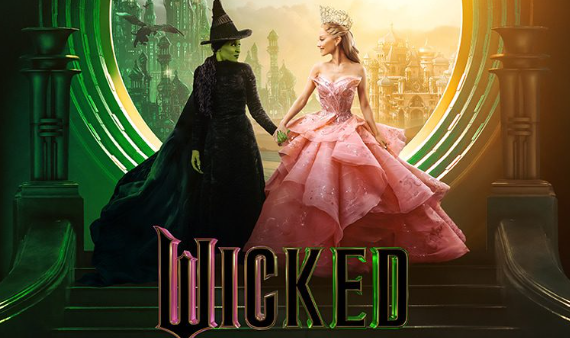Wicked: Part One was one of the most anticipated films of the year by both the broadway community and general moviegoers. The film is based on the broadway musical, Wicked, which is based on the novel by Greogry Maguire. This novel is a loose spin off of L. Frank Baum’s story The Wonderful Wizard of Oz. The story takes place both before and after Dorothy arrives in Oz, following two witches—Elphaba (the Wicked Witch of the West) and Galinda (Glinda the Good)—through their meeting at Shiz University, their unlikely friendship, and Elphaba’s eventual demise. Much like the first act of the musical, part one ends on the dramatic events of “Defying Gravity,” with part two set to premiere on November 21st, 2025.
There has been speculation of a Wicked musical movie as early as 2004, but serious progress didn’t occur until 2016 after a director had finally been selected. Unfortunately, the production was put on hold in 2018, and their scheduled premiere date was given to the box office disaster that was Cats. After the events of Covid and the subsequent rebuilding of Hollywood, Jon M. Chu was named the director in 2021, and production started with Cynthia Erivo and Ariana Grande as Elphaba and Galinda, respectively. The film trails on the 20th anniversary of the Broadway musical, as well as Wicked’s rise to being the second highest grossing musical on Broadway.
Like the novel and musical, the film explores complex themes and commentary about the nature of good and evil, questioning whether wickedness is a born trait or if it is thrusted upon someone. The narrative of Glinda as the “good” witch and Elphaba as the “wicked” witch is turned on its head as the film delves into their true personalities and motives. The story also tackles themes of race and prejudice, exploring how the Wicked Witch of the West came to be. The central question of the film is whether Elphaba is truly wicked or even the only “wicked” one within the story.
What sets this film apart from other big-budget blockbusters is its immersive approach. Rather than relying on green screens and CGI, the production used practical sets to capture the feeling of Oz, avoiding computer generated backgrounds. The landscape of Munchkinland, for example, included planting 9 million tulips to create the lush landscape. With an estimated budget of $150 million, the film nearly recouped the entire investment during opening weekend, grossing $112 million.
Another noteworthy aspect of the film is that the cast sang live on set rather than lip-syncing. This adds a whole other level of authenticity to the film, as the actors were able to capture the nuances and quirks of live singing while becoming fully immersed in their roles. Singing live is difficult enough, but when combined with performing their own stunts, it reaches another level entirely. Erivo, for instance, chose to perform her own stunts while singing, meaning she had to wear layers of harnesses to fly around the set while also hitting the high notes and belting “Defying Gravity.” Both Erivo and Grande seem fully invested in their characters, appearing as though they were living as the witches rather than merely playing them on the screen. Their portrayals are breathtaking and are deserving of awards.
Many people criticize the film for being split into two parts, but this decision actually sets the film apart from its musical and novel counterparts. With a runtime of 2 hours and 40 minutes, part one surpasses the entire length of the broadway musical. The film gives the story room to breathe, allowing for a deeper understanding of Elphaba’s backstory and a richer connection between the witches—something that felt rushed in the stage adaptation. The film also draws more from Maguire’s novel, offering a deeper social and political commentary on wickedness, as well as spectacles. Even though part two is still to come, I highly recommend going out to the theater and seeing Wicked: Part One.







